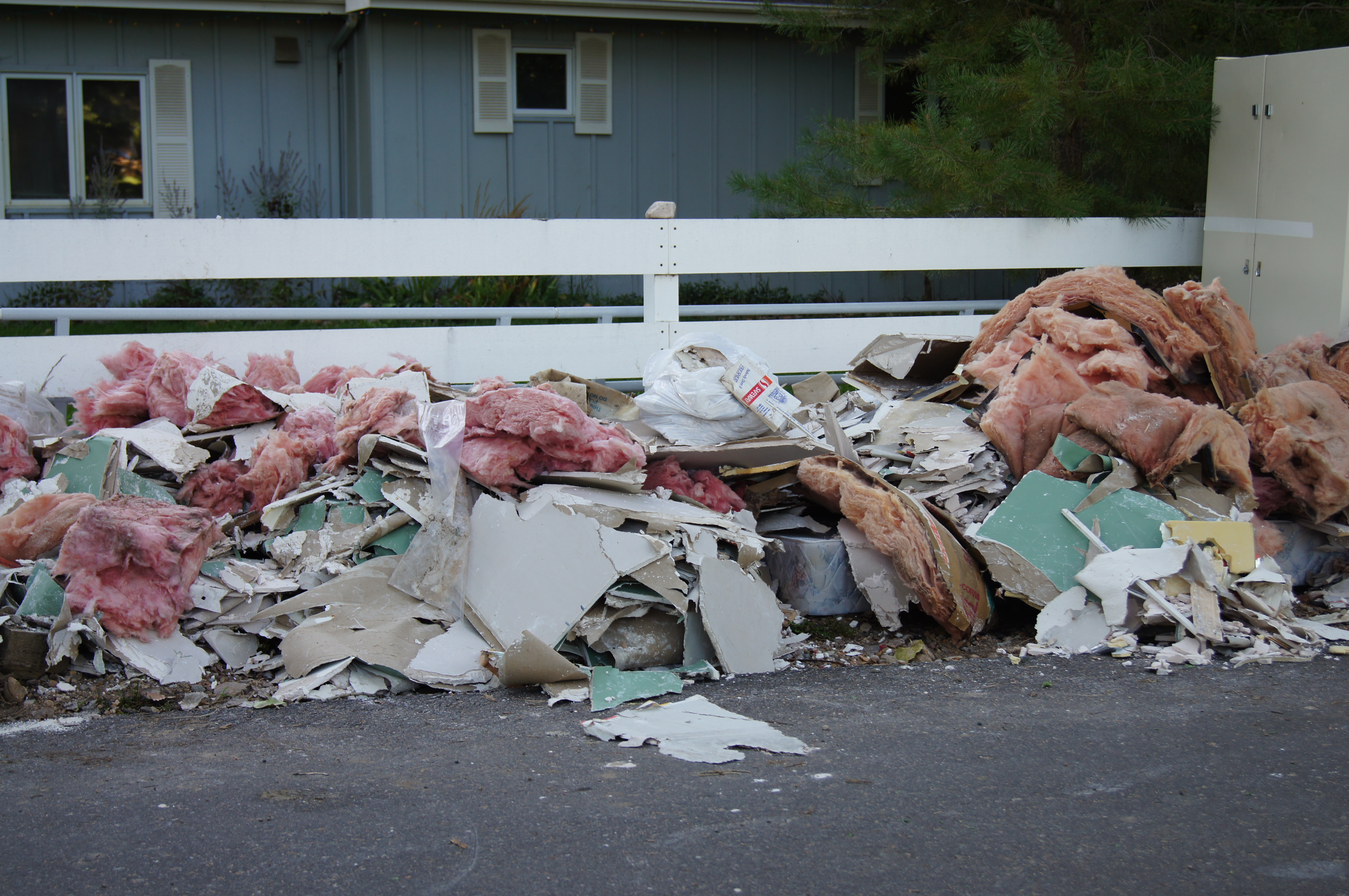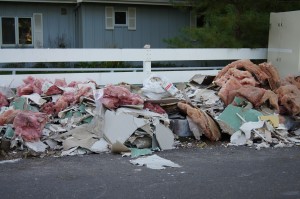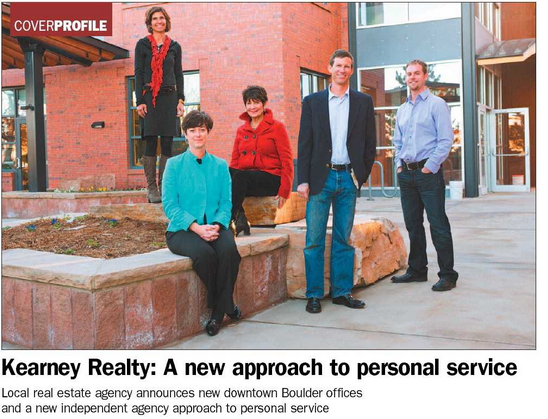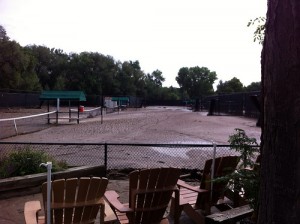
by Neil Kearney | Oct 2, 2013 | Boulder Real Estate, General Real Estate Advice
 This is a follow-up on my previous post on the floods we had locally in September.
This is a follow-up on my previous post on the floods we had locally in September.
Many homes that were affected by water damage had never had any water infiltration previously. The combination of sustained rain, rising ground water and in some cases sewer backups caused a litany of water problems throughout the area. On my street about one in four houses was affected so it’s not fair to say only certain areas were hit or that others were dry. It was a regional problem with tens of thousands of homes affected.
So how will this affect a homeowner as they look to sell a home that was damaged and how will buyers view those homes. Three words come to mind: cleanup, documentation and disclosure.
In order for a buyer to feel good about a home that has had extensive water damage they will need to know what happened, how it was cleaned up and how it can be prevented from happening again. The proper cleanup should have started weeks ago by removing everything that was wet. This includes personal belongings like boxes, bedding, furniture but more importantly means carpet, baseboards, drywall and insulation. Once all porous materials are removed they must be dried out thoroughly and treated with a anti-mold solution. In addition all concrete needs to be cleaned with a bleach solution (1 cup to every 5 gallons of water). Once the cleaning and drying is complete the finishes are ready to be re-done with new materials.
While everything is fresh in your memory it would be a really good idea to document exactly what happened to your house. This should take the form of a written documents supported by photos at every stage of the process. In my experience, the more a buyer knows and the more forthright they think the seller is being the less spooked they will get during the purchase process.
Sellers are required by Colorado law to disclose every material fact of the house. Most sellers satisfy their disclosure requirement by filling out the Sellers Property Disclosure form. The second question on this form is: “Do the following conditions now exist or have they ever existed: Moisture and/or water problems”. The answer for so many of us (me included) is now a resounding YES. But if you left it at that, a check mark I think a buyer would still have many questions. So this is when your documentation comes in to tell the buyer 1) How it happened 2) How it was cleaned up 3) What was done so that it won’t happen again. Not only would you have fulfilled your statutory obligation you would have made the buyer feel more comfortable about what happened. The goal being that once everything is laid out in detail it is a non-issue.
UPDATE: Boulder County has created a form that gives a format for documentation of the water damage remediation. To view and use the form click on this link moldremediation.

by Neil Kearney | Sep 27, 2013 | Boulder Real Estate, General Real Estate Advice

Flickr photo courtesy of JgColorado
Colorado is a semi-arid region. In Boulder, we average just under 25 inches of precipitation. Our normal weather this time of year is clear and crisp with warm days and cool nights. If we do get rain, it comes from the west over the mountains and quickly passes to the east where the large storms form and move like islands across the Great Plains. However, starting on Monday September 9th, the convergence of a monsoon flow from the south met a stalled cool front from the north caused an unprecedented amount of rainfall. During a six day period we received almost 75% of our annual expected rainfall. The result was massive flooding. Here are some of my thoughts regarding what has happened and what might happen next. The Daily Camera has a comprehensive series of articles on the flood posted here. What I present here is just a small slice of the story as it pertains to me and to what I pay attention to. The Event:
The Cleanup:
- As the rains subsided and the water ran downstream the damage to homes became apparent. I started Friday the 13th by cutting out and hauling outside a thoroughly soaked carpet and pad. We also had to move out all of the other stuff that was in storage. Many of it was lost due to water damage. So long old yearbooks, school notes and files. The city in conjunction with Western Disposal began to set out roll off dumpsters from residents to place flood damaged debris. Many of these locations were overrun and the overflow of destroyed items took over parking lots and streets.
- Cleanup is hard work and for those with sewage festering in the basement it is a dangerous and dirty job. The local restoration, cleanup companies were overwhelmed with the calls and soon there were trucks from all over the country in town to help with the cleanup. I’m lucky, I am handy, healthy and have the help of my family and the four of us were able to clear out, dry out, cut out the bottom 8 inches of drywall and haul it all away. But many needed others to help and while there were many, many volunteers who were the saving grace to some, many have been forced to pay the huge sums charged by cleanup companies to do the work. A typical charge was over $5000 to do the work.
What’s Next:
 Hardship: Most people have figured out by now that flooding of any sort isn’t covered by the typical homeowners insurance. This means that the cost of cleanup and repair will come directly out of personal back accounts. This hurts for some and is impossible for others. I suspect that many basements that were formally finished will remain at least partially unfinished for quite some time.
Hardship: Most people have figured out by now that flooding of any sort isn’t covered by the typical homeowners insurance. This means that the cost of cleanup and repair will come directly out of personal back accounts. This hurts for some and is impossible for others. I suspect that many basements that were formally finished will remain at least partially unfinished for quite some time.- Rebuilding: Being in the carpet, roofing or drywall business would be good right about now. There will be a huge effort to get work done and I suspect that many contractors will be busy for months to come making repairs, installing carpets and doing work that will help prevent it from happening again.
- Changes: We have been dodging this flood for a long time. We were overdue and historically we have flood events to some extent every 10 years or so. So what we can best do now beyond rebuilding is to learn from this and make sure we are better prepared for the future. This will hopefully happen at the community level but it needs to happen at the individual level as well. Each of us needs to make sure that we have the right tools (there were 1,000 people in line to get sump pumps on Saturday morning when a truckload arrived) and make sure our drainage is as minor as it could be.
The Real Estate View:
- Under Contract: I don’t have exact statistics on this but I heard many stories about damage to houses that were under contract getting ready to close. I lucked out, all of my pending sales were high and dry and my listings mostly made it out unscathed. What happens if there is damage to a house right before closing? Paragraph 19.1 in the Colorado Contract to Buy and Sell Real Estate address this instance. It says that the seller is obligated to repair any damage. If the damage isn’t fixed by closing or if the total damage exceeds 10% of the contract price then the buyer has a right to terminate the contract or to continue with the contract and work out the details of payment and repair with the seller and the insurance company.
- Disclosure: Sellers are required to disclose whether there has ever been any water problems in the house. There was a huge percentage of homes that had never had any water and now have to say “yes”. It is now important for sellers and those who will sell in the future (yes, this means you) to document the extent of the water, explain the reason and detail the cleanup methods and timing.
- Flood maps: It turns out that flood maps are theoretical and inaccurate. I have seen where the flow of Boulder Creek was characteristic of a 50 year flood. On the other hand, neighborhoods were flooded out that were outside of the 500 year flood zone. The bottom line is that the maps will need to be redrawn with actual data. I’m guessing the result will be more people in the flood zone.
- Insurance: Most people don’t have flood insurance. If you are outside the 100 year flood zone on the official maps flood insurance is optional. Homeowners insurance doesn’t include flood damage so most people with damage are left without financial assistance. FEMA assistance is available to those with damage (Call 800-621-3362) and many will be taking out loans to re-build. We had sump-pump rider on our policy and ended up with a check for $1500 which will help with new carpet and drywall repair.
After living in Boulder for over 40 years I now have a new appreciation for what is possible. I know I will be looking at real estate with a different eye.

by Neil Kearney | Jul 17, 2013 | Boulder County Housing Trends, Boulder Real Estate, Statistics
Boulder County Real Estate Statistics June 2013 from Neil Kearney
Sales in Boulder County slowed a bit in June but year-to-date sales are still up 9.4%. Prices are up and inventory is still low. Last year sales peaked in June and this year we may be following suit. Spring tends to be the busiest time of year and the number of buyers in the market usually sees a drop by the end of June.
In the slide show you will see a graph showing the number of homes that went under contract on a weekly basis over the past four years. During the week between July 4th and July 11th there was a huge drop in new accepted contracts. I wonder if this is a trend caused by an increase in interest rates or if it is a blip caused by vacation schedules?

by Neil Kearney | May 3, 2013 | Boulder Real Estate, General Real Estate Advice
 The Boulder real estate market is moving swiftly at the moment. Not Boulder Creek swift but roller coaster fast. Buyers swoop in on desirable new listings like hungry vultures waiting for an injured zebra to stumble its last steps on the barren plain. If a buyer wants to be competitive they must be ready to see a new listing right when it comes on the market and ready to make a good offer almost immediately. Good fortune favors the swift.
The Boulder real estate market is moving swiftly at the moment. Not Boulder Creek swift but roller coaster fast. Buyers swoop in on desirable new listings like hungry vultures waiting for an injured zebra to stumble its last steps on the barren plain. If a buyer wants to be competitive they must be ready to see a new listing right when it comes on the market and ready to make a good offer almost immediately. Good fortune favors the swift.
But right now, even with the best efforts being put forth, houses are hitting the MLS already under contract. But how can this be? Is there a super buyer waiting for the sign to go up and beating everyone else to the punch? The answer is no. What’s happening is that the listing agent is selling the house before it enters the MLS via a whisper campaign. This can take a few different forms.
The first and most prevalent form of this practice is the inter-office preview. This is especially prevalent in larger offices, but can happen in any office where there is more than one agent. This can be as innocuous as talk around the water cooler or an interoffice memo system giving agents within the office “first shot” at upcoming listings.
The second prevalent method is the “coming soon” sign which is put up at the home before the house is offered on the MLS. If a potential buyer would stumble upon the sign they would need to call the agent for more details. The goal being that the agent would possibly be able to bring the buyer to the transaction in addition to representing the seller.
This practice, in all its forms, in my opinion, is not adding to the professional image of Realtors. Our pledge and fiduciary duty to our clients is to “promote the interests of the Seller with the utmost good faith, loyalty, and fidelity”. In short our job is to do the best job for our clients. I would argue that in a market such as ours, where multiple offers are a normal occurrence and offers over list price are very common, a whisper campaign isn’t necessarily in the best interest of the seller. It may be convenient for the seller and adhere to the terms of the listing contract. But if the listing agent is only marketing the home to a very small pool of “in the know” Realtors and buyers, the best interests of the seller are pushed aside.
It’s our job to expose a listing to the largest pool of buyers possible so that the best offer can come forward. I’ll illustrate with an analogy, if we are fishing in a small bucket (within an office or those who happen to see a sign) we are not going to catch the big fish swimming in the lake (all other buyers represented by other Realtor’s or who don’t happen to drive by). When Realtor’s only expose a listing to a limited group I think they are doing a dis-service to their clients.
 I currently have five really nice listings coming up in the next two weeks. The sellers are currently getting ready and I’m behind the scenes getting ready with the marketing. But you won’t hear about them from me until you see them hit the MLS. No coming soon sign, no office emails, no blog posts… When it comes on the market it will be released for all to see and it will be up to the buyers out there who will make the best offer. It’s my intention to work in the best interests of my clients, not my best interests or my offices best interests.
I currently have five really nice listings coming up in the next two weeks. The sellers are currently getting ready and I’m behind the scenes getting ready with the marketing. But you won’t hear about them from me until you see them hit the MLS. No coming soon sign, no office emails, no blog posts… When it comes on the market it will be released for all to see and it will be up to the buyers out there who will make the best offer. It’s my intention to work in the best interests of my clients, not my best interests or my offices best interests.
In a slower market this practice may be beneficial but right now I think it’s the opposite.

by Neil Kearney | Mar 22, 2013 | Boulder Real Estate, For Buyers
 Budding trees, singing birds and swarms of home buyers. These are the signs that spring is just around the corner. The first two happen every year but this year especially home buyers are our early and in droves. As we learned from the ‘birds and the bees’, ying and yang and Marvel Comic Books, it takes opposing forces to create balance. Right now the balance of the Boulder real estate market is off kilter. There are not enough homes on the market to satisfy the demand of the buyers.
Budding trees, singing birds and swarms of home buyers. These are the signs that spring is just around the corner. The first two happen every year but this year especially home buyers are our early and in droves. As we learned from the ‘birds and the bees’, ying and yang and Marvel Comic Books, it takes opposing forces to create balance. Right now the balance of the Boulder real estate market is off kilter. There are not enough homes on the market to satisfy the demand of the buyers.
Over the past week 171 properties have come on the market in Boulder County. Already 24% of those homes have gone under contract. If you look back two weeks that number jumps to 32%. It is a fast moving market. We just listed a home in Louisville and over the three days on the market there have been 18 showings. Multiple offers are very common and many buyers are getting caught up in the frenzy. Here are the top three mistakes I see being made in this market.
Paying Too Much
 When you are at the supermarket comparing products and prices is easy. For example, you want some soup so you compare the choices available and decide; what flavor, what brand, what size, etc. It is easy to decide because there are ample choices and whether you are a value shopper looking for a generic brand or are willing to pay for organic soup with a brand name, you can easily make that choice. But if you go to a remote store, like you often find near a campground with one soup choice the decision is whether paying $5 for a can of Campbells is worth it to you. The scarcity in choice allows the seller to raise price and at that price soup will be worth it for some and not worth it for others.
When you are at the supermarket comparing products and prices is easy. For example, you want some soup so you compare the choices available and decide; what flavor, what brand, what size, etc. It is easy to decide because there are ample choices and whether you are a value shopper looking for a generic brand or are willing to pay for organic soup with a brand name, you can easily make that choice. But if you go to a remote store, like you often find near a campground with one soup choice the decision is whether paying $5 for a can of Campbells is worth it to you. The scarcity in choice allows the seller to raise price and at that price soup will be worth it for some and not worth it for others.
Pardon the extended metaphor, but right now there is a scarcity in the real estate market and buyers are faced with buying decisions with limited options. In many cases the decision is, do I pay more than seems reasonable or do I wait and hope that something better comes on the market. I have seen many sellers pushing the market and some are being rewarded by buyers willing to pay high prices.
So, if you are a buyer how do you balance being competitive in this market where 18 buyers are looking at the same property within a few days and making a smart decision. The first tip is to do research like an appraiser would do. Look at the sales in the neighborhood over the past six months or year (depending upon how many have sold) and find the homes that are most like the home you are looking at. Compare the upgrades, price per square foot and I like to compare the assessed values as set by the county appraiser. After comparing the sold homes to the home you are interested in you should have a good idea if you are within a reasonable range or if you are going to be setting a new record for the neighborhood. If you are getting a loan, the appraiser hired by the bank will be doing the same analysis and they are much more conservative than the normal buyer who is newly in love and is riding an adrenaline high from beating all of those other buyers. If you have paid too much the appraisal will stop the sale. So save yourself some time and money and work with your Realtor to see if what you are paying is reasonable.
Getting Caught Up In A Scarcity Mentality
When houses are flying off of the market and you may have missed out on a home or two, it may be easy to start to think that the house you have just seen (and might just work) will be the only one and if we don’t make an offer now… Home buying is a process and sometimes there is a delicate balance between patience and action. This is where advice from a good buyers agent is invaluable. The truth is, even though you think that there will never be another house like the one you just lost out on, new listings are coming on the market all the time. A home buyer must always look forward and never dwell on houses that “might have been”. The right state of mind is one that objectively looks at the options and sees each house that doesn’t work as one step closer to the one that will work.
Not Acting Quickly Enough
In a sellers market the competition for good houses is fierce. Being a part-time buyer is frustrating and futile in many ways. In order to be successful you must be ready to pounce on a good home. Here are the steps that a buyer must take to be a active buyer, ready to buy.
- Financing Ready – You must have your ducks in a row. A lender letter is required with all offers and it is best that you are already in the process of loan approval, just waiting for the property, verification of your information and an appraisal. You also must have liquid funds for earnest money ready to go.
- Quick Information – Knowing about the homes on the market is the next hurdle. If you are waiting for the Sunday paper you are most likely missing most of the homes. What I do for my clients is to set them up with a search that automatically scourers the MLS for new listings every few hours and sends us both an email with the results.
- Quick Showings – Once you know about the new listings you need to get out there are see them quickly. Flexibility is a key and seeing promising new listings on the first day gives you an advantage. I showed a listing this week that had just come on the market at 10 am. We met at 5 pm and there were four other groups meeting there at the same time. What a zoo!
- Quick Offer – Being ready to make an offer quickly is another key. Be ready to analyze the data (see
 above) and make a strong offer is key to getting an offer accepted. A few weeks back I was able to make an offer on the spot at the house by writing the contract on my IPad and having the buyers sign on the spot. The seller and listing agent were about to meet so we had a tight deadline and we were able to meet it.
above) and make a strong offer is key to getting an offer accepted. A few weeks back I was able to make an offer on the spot at the house by writing the contract on my IPad and having the buyers sign on the spot. The seller and listing agent were about to meet so we had a tight deadline and we were able to meet it.
- Be Smart- As coach John Wooden said “Be quick, but don’t hurry.” Buying real estate is a long term decision with large consequences if you don’t get it right. Be ready to make your best offer but don’t get caught up in the wave of competition.
Buying a home in a tight market is a stressful situation and under pressure it is much easier to make a poor decision. I hope the three tips above help you navigate the process a bit easier.
If you are looking for a proactive buyers agent call me Neil Kearney 303.818.4055

by Neil Kearney | Jan 1, 2013 | Boulder Real Estate
Happy New Year!
This past Friday Kearney Realty was featured in a cover article in the Daily Camera’s At Home section. The full article can be read by going to this website.

Here are a few excerpts from the article:
Kearney Realty, a trusted name in Boulder real estate for over 20 years, has just announced the opening of their new downtown Boulder offices in the Iron Flats Building at 2400 Spruce Street.
At the same time, the agency is re-organizing into an independent, boutique agency designed to provide a high level of personalized service to real estate buyers and sellers.
“We are taking the knowledge, skills and principles from our decades of experience in Front Range real estate and transforming our team into an independent agency,” says Neil Kearney, owner. “Real estate is a personal experience, and we know that we can serve our clients best by providing personalized service. We like to describe it as a ‘high touch, high tech, five-star customer experience.”
“We bring a real mindset of service to work everyday,” Neil Kearney explains. “We’re not focused on making that one big sale, but rather on developing long-term relationships with our clients. When we provide great service, we know the rest will take care of itself. People today have access to plenty of information on properties for sale, for instance. Our job is to provide the expertise that helps our clients make good decisions based on that information. Each of our full time associates is empowered and engaged to give top quality service based on impeccable ethics, consistent systems, professional development and cutting edge tools.”
“We’re a small agency with a big handle on technology, using all of the most current methods and tools that larger companies employ and bringing great efficiencies to every transaction. As a seller, you want to ensure that your property is marketed in the most effective ways possible. And as a buyer, you want a complete picture of values, neighborhoods, and anything that might impact the desirability of a property. In the end, it’s still about our personal understanding of your needs and how to solve them.”
I am really excited to be starting the year with a new focus on our local personalized brand and an excitement to implement new ideas on how to better serve our clients. I’m also really excited to be working in our new location at 24th and Spruce in the Iron Flats building. As we get settled more I will share more about our new location.
Kearney Realty article 12-28-2012

Page 4 of 6« First«...23456»

 This is a follow-up on my previous post on the floods we had locally in September.
This is a follow-up on my previous post on the floods we had locally in September.














